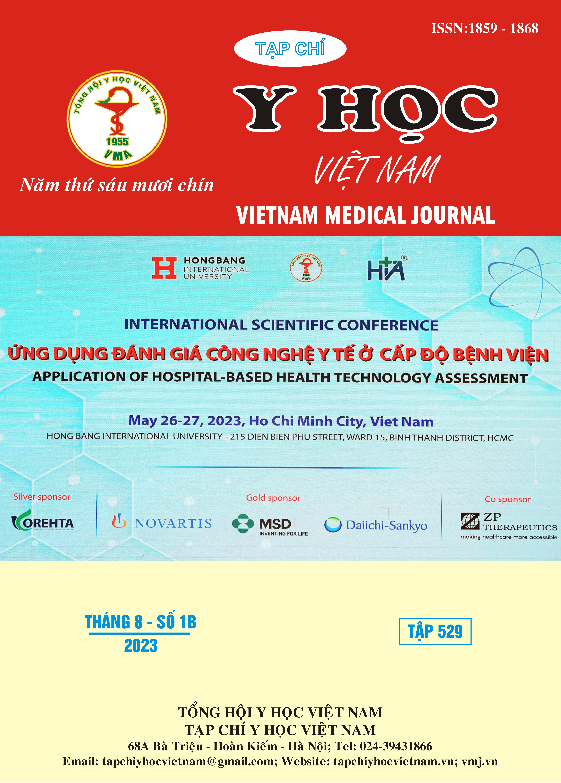DETERMINATION OF CLINICAL AND PARACLINICAL CHARACTERISTICS OF COLON CANCER PATIENTS UNDERGOING LAPAROSCOPIC COLECTOMY
Main Article Content
Abstract
Objectives: To determine the clinical and subclinical characteristics of patients with right colon cancer who must undergo laparoscopic colectomy and some related factors. Subjects and methods: Prospective study on 60 colon adenocarcinoma patients who had to undergo laparoscopic colectomy during the period from 1.2016 to 12.2021. Assess the rate of symptoms, the relationship between symptoms, no clinical symptoms with tumor invasion, cancer stage. Results: Mean age 54.3, the rate of symptoms of abdominal pain, digestive disorders, bloody stools, fatigue, weight loss, incomplete intestinal obstruction and Hemoglobin <10g/dl respectively: 81.7%, 53.3%, 26.7%, 13.3%, 10% and 35%. There were 5 patients (8.3%) without clinical symptoms, diagnosed by screening endoscopy. The number of asymptomatic patients with pathology results in stage I is 80%, stage II is 20%, while only 50% of patients have symptoms in stages I, II; This difference is significant with P=0.005. Group of symptomatic patients with tumor at T3, T4a was significantly higher than in the asymptomatic group, P = 0.02. There were a total of 9 patients with metastatic disease in the group of symptomatic patients, but the difference was not significant (P=1). Conclusion: Patients with non-clinical right colorectal cancer are often at an early stage when compared with symptomatic patients and the difference is statistically significant.
Article Details
Keywords
right colon cancer, laparoscopic surgery, symptoms
References
2. Amri R, Bordeianou LG, Sylla P, Berger DL (2013). Impact of screening colonoscopy on outcomes in colon cancer surgery. JAMA Surg. 2013;148(8):747.
3. Arnold M, Sierra MS, Laversanne M, et al. Global patterns and trends in colorectal cancer incidence and mortality. Gut. 2017;66:683-691.
4. Brierley JD, Gospodarowicz MK, Wittekind C, eds. TNM Classification of Malignant Tumours. 8th edition. Oxford: John Wiley & Sons, Inc.; 2016.
5. Cancer Genome Atlas Network. Comprehensive molecular characterization of human colon and rectal cancer. Nature. 2012;487(7407):330-337.
6. Ford AC, Veldhuyzen van Zanten SJ, Rodgers CC et al (2008). Diagnostic utility of alarm features for colorectal cancer: systematic review and meta-analysis. Gut. 57(11): 1545.
7. Goodman D, Irvin TT (1993). Delay in the diagnosis and prognosis of carcinoma of the right colon. Br J Surg. 1993;80(10):1327.
8. Moreno CC, Mittal PK (2016). Colorectal Cancer Initial Diagnosis: Screening Colonoscopy, Diagnostic Colonoscopy, or Emergent Surgery, and Tumor Stage and Size at Initial Presentation. Clin Colorectal Cancer. 2016 Mar;15(1):67-73. Epub 2015 Jul 29.
9. Torre LA, Siegel RL, Ward EM, Jemal A. Global cancer incidence and mortality rates and trends-an update. Cancer Epidemiol Biomarkers Prev. 2016;25:16-27.


